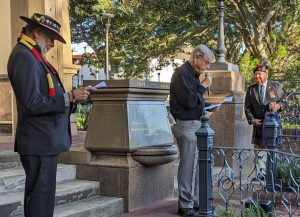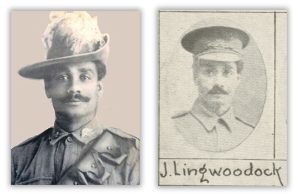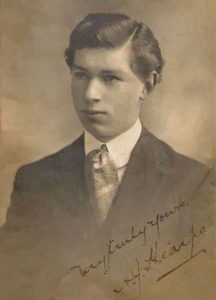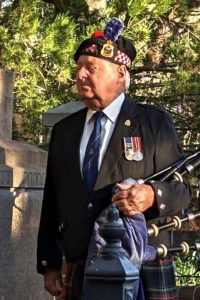By Max Solling, Bulletin 4/2024, June

This article is the first of three drawn from Max Solling’s moving address at the 2024 Anzac Day ceremony at the Glebe War Memorial. See the full text of Max’s address.
Leading the service on this year’s Anzac Day, Pastor Ray Minniecon, a Kabikabi and Gurang-Gurang man from Queensland, has dedicated his life to supporting members of the Stolen Generations of Aboriginal people.
Ray has a strong connection with the defence forces; his grandfather James Lingwoodock (1895–1960), an excellent horseman like many stockmen, joined the 11th Light Horse in 1917. He was part of reinforcements known as the ‘Queensland Black Watch’ in the Jordan Valley: 28 of its 32 members were Indigenous. Ray’s two brothers, Sterling known as ‘Sonny’ and Phillip, served in the Vietnam War. Ray was a transport driver in the Citizen Military Forces (CMF).

Somewhere between 1,000 and 1,500 Indigenous Australians donned the khaki, according to recent research. They defied racist restrictions but on their return to civilian life were denied full citizenship rights. Yet Indigenous Australian soldiers shared a commonality of service and sacrifice made by all Australian soldiers. Once in the AIF they were treated as equals, paid the same as other soldiers and generally accepted without prejudice.
Alfred John Hearps, son of a Palawa man from Forth Tasmania, enlisted as a 19-year-old in the AIF in 1914. He was at the Gallipoli landing and as a second lieutenant became the first Indigenous Australian to be commissioned. Hearps was killed on 19 August 1916 on the Somme. With no known grave, his name appears on the Villers-Bretonneux memorial.

Writing letters and keeping diaries helped soldiers cope with the chaos surrounding them at the front. Charles Tednee Blackman (1895–1966), an Indigenous farm hand from Childers near Bundaberg, enlisted in 1915 and was followed by elder brothers Thomas and Alfred. He survived two and a half years of the morass of trench warfare in France. Charles Blackman’s letters home reveal the sense of duty, fears of battle, pleasures of leave, camaraderie and esprit de corps with white comrades, and loneliness of being so far from home – common to all soldiers.

Rob McLean, 30 years piping for Glebe’s Anzac Day
A constant figure at Glebe’s annual services since 1994 has been our wonderful piper Rob McLean, who plays the lament. Rob’s father, John McLean, was born at Kinlochleven Argyllshire in the Scottish Highlands and emigrated to Sydney with his parents in 1929.
After Rob left school in 1968, he joined the St George–Sutherland Pipe Band after which he joined the Sydney University Regiment Army Reserve where he served for 32 years. We were lucky enough to get Rob in 1994 through his involvement in the Sydney University Regiment. Rob has played at Burwood’s Anzac Day dawn service for over thirty years, leaving Burwood by 7 am to get to Glebe for our 7:30 service. After finishing at Glebe, Rob heads into the City to join the Pipers and play at the march.








There are no comments yet. Please leave yours.